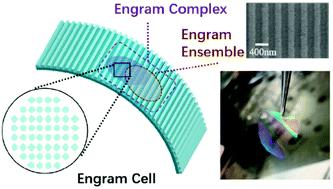当前位置:
X-MOL 学术
›
Nanoscale Horiz.
›
论文详情
Our official English website, www.x-mol.net, welcomes your
feedback! (Note: you will need to create a separate account there.)
A nanoimprinted artificial engram device
Nanoscale Horizons ( IF 8.0 ) Pub Date : 2021-07-08 , DOI: 10.1039/d1nh00064k Xuesong Li 1 , Pan Zeng , Feilong Wang , Dai Zhang , Yi Zhou , Rongqing Liang , Qiongrong Ou , Xiang Wu , Shuyu Zhang
Nanoscale Horizons ( IF 8.0 ) Pub Date : 2021-07-08 , DOI: 10.1039/d1nh00064k Xuesong Li 1 , Pan Zeng , Feilong Wang , Dai Zhang , Yi Zhou , Rongqing Liang , Qiongrong Ou , Xiang Wu , Shuyu Zhang
Affiliation

|
At present, mainstream neuromorphic hardware is based on artificial synapses; however, an engram, instead of a synapse, has recently been confirmed as the basic unit of memory, which verifies the engram theory proposed by Richard Semon in 1904. Here, we demonstrate an artificial engram device based on a nanoimprinted curable resin. The variation in the relative diffraction efficiency based on the asymmetric reversible topological change of the nanoimprinted resin enables the device to meet all the requirements for artificial engrams, including synaptic plasticity, long memory storage time, asymmetric memorizing–forgetting behaviour and measurable changes and responses. On this basis, we demonstrate the concept of realizing memory formation, memory manipulation and implantation, and memory consolidation using our artificial engram device in comparison with its biological counterpart.
中文翻译:

一种纳米压印人工印迹装置
目前主流的神经拟态硬件都是基于人工突触;然而,最近证实了印迹而不是突触是记忆的基本单位,这验证了 Richard Semon 在 1904 年提出的印迹理论。在这里,我们展示了一种基于纳米压印可固化树脂的人工印迹装置。基于纳米压印树脂的不对称可逆拓扑变化的相对衍射效率的变化使该设备能够满足人工印迹的所有要求,包括突触可塑性、长记忆存储时间、不对称记忆-遗忘行为以及可测量的变化和响应。在此基础上,我们展示了实现记忆形成、记忆操作和植入的概念,
更新日期:2021-07-13
中文翻译:

一种纳米压印人工印迹装置
目前主流的神经拟态硬件都是基于人工突触;然而,最近证实了印迹而不是突触是记忆的基本单位,这验证了 Richard Semon 在 1904 年提出的印迹理论。在这里,我们展示了一种基于纳米压印可固化树脂的人工印迹装置。基于纳米压印树脂的不对称可逆拓扑变化的相对衍射效率的变化使该设备能够满足人工印迹的所有要求,包括突触可塑性、长记忆存储时间、不对称记忆-遗忘行为以及可测量的变化和响应。在此基础上,我们展示了实现记忆形成、记忆操作和植入的概念,











































 京公网安备 11010802027423号
京公网安备 11010802027423号